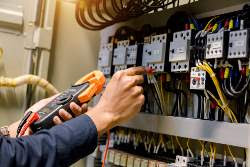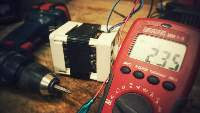
Basic safety

Electrical basic safety
* Do not work with exposed conductors carrying 50 volts or more.
* Make sure the electrical device is properly connected, grounded, and in good working order.
* Extension cords cannot be used as permanent wiring and must be removed after temporary use for an activity or event.
* Surge suppressors with built-in circuit breakers can be used for a long time and are available with three, six, and 15 foot-long rods.
* High amperage equipment such as space heaters, portable air conditioners, and other appliances must be plugged directly into the reception of the permanent wall.
* Do not access, use, or alter the electrical service of any building, including circuit breaker panels, unless you are specifically qualified and authorized to do so.
* Wet environments may increase the risk of electric shock.
* For more information about electrical cords, including extension cords and electrical taps, see the extension cords, surge suppressors, and power strips focus sheets.
Proper maintenance and housekeeping
* Maintain at least 30 "(inches) of clearance in front of the electrical panels to ensure a safe environment for the facilities to the workers properly.
* Ensure that all the junction boxes should be covered.
* What can you do to be safe?
* Avoid activities requiring training
* Working with exposed conductors carrying 50 volts or more
* Repairing or altering any electrical appliance
* Opening the case, or removing the barrier guard of any device that uses electricity
* Using any instrument or meter to measure for the presence of electricity
* Resetting a stranded circuit breaker, or replacing a blown fuse
* Ask a qualified person to do these tasks.
Grounding
To prevent electrical hazards, always make sure the equipment is properly grounded. Electrical grounding provides an alternative route for a person to follow the power instead of going through it. Equipment with a grounding prong must be plugged into the extension cord along the ground; Grounding plugs should not be removed from equipment.
Wet place
Ground fault circuit interrupter (GFCI) should be used when using electricity in wet or humid locations, including outdoor locations. GFCI ensures that any electric shock is brief. Although painful, it can be fatal because the GFCI currently creates a ground fault or leak.
Additional information about GFCI devices can be found in the Ground Fault Circuit Interpreter Focus Sheet.
The strike
When servicing and maintenance tasks involve electrical and electrical equipment, you must prevent unexpected startup of the equipment. More information on lockout / tag-out procedures is available on the Hazardous Energy Control page.
Electrical protection: circuit breakers, load centers, and fuses
Take a deep dive into the three integral parts related to the circuit - the circuit breaker, load center, and fuses - and how to use them safely.
Electrical safety is paramount at any job location. When there are electrical issues, a charged electrician should always be involved. An electrical accident at your workplace can be disastrous, injure employees, and cost you dearly. Ensuring a safe workplace and conforming to OSHA, using best practices in electrical safety.
In this post, you have to make important suggestions on the three main pieces of equipment required in the electrical ecosystem: circuit breakers, load centers, and fuses. Know what they are and their importance for electrical safety.

Electrical instrument

Post a Comment
Please do not enter any spam link in the comment box.